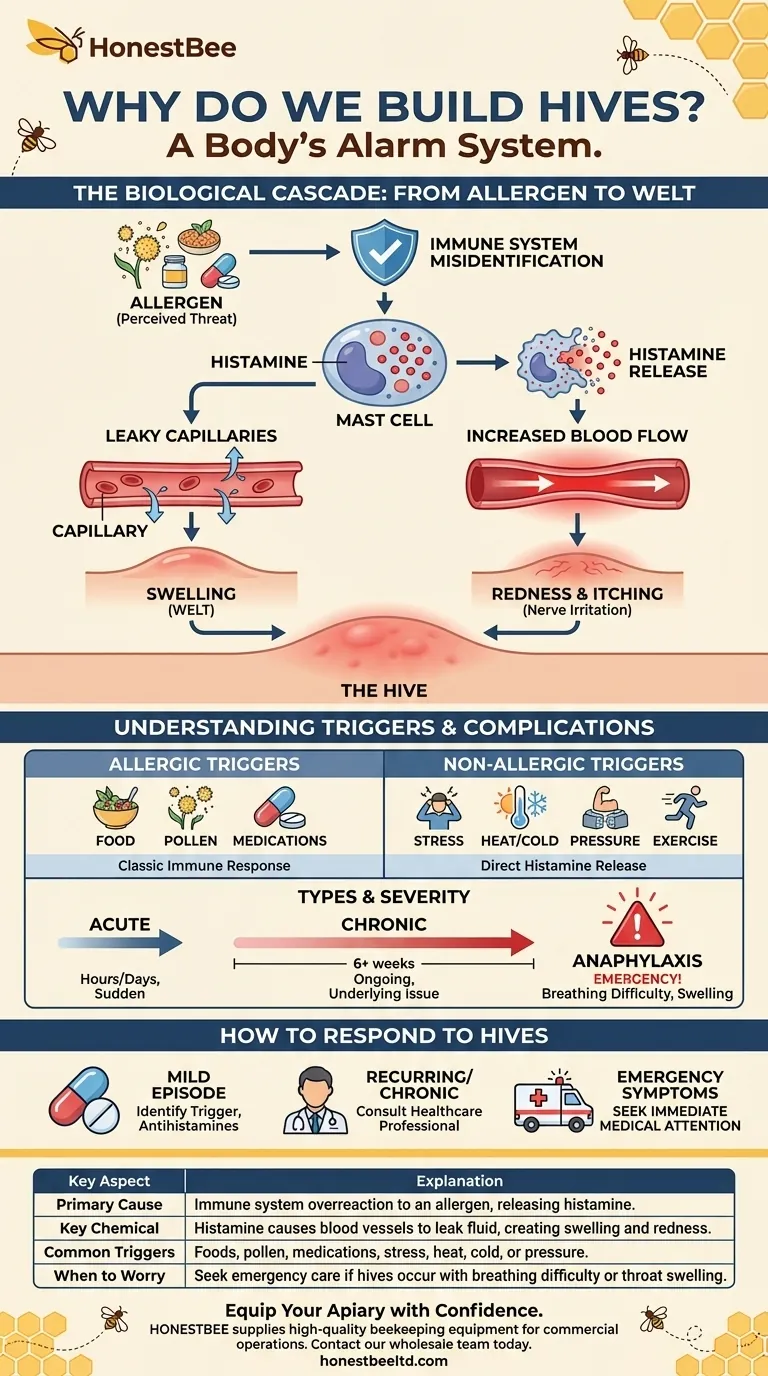Hives are your body's alarm system made visible. They are raised, red welts that appear on your skin as the direct result of an allergic reaction. This reaction is triggered when your immune system encounters a substance it mistakenly identifies as a threat, known as an allergen.
The core reason you develop hives is not the allergen itself, but your body's overzealous response to it. Your immune system releases a chemical called histamine, which causes small blood vessels to leak fluid into the skin, creating the characteristic swelling and redness.

The Biological Cascade: From Allergen to Welt
To understand hives, you must understand the chain of events that occurs beneath your skin. It's a rapid defensive maneuver against a perceived, but often harmless, invader.
The Immune System's Misidentification
Your immune system's primary job is to identify and neutralize genuine threats like bacteria and viruses.
Sometimes, it makes a mistake. It can flag a harmless substance—such as pollen, a food protein, or medication—as a dangerous invader. This substance is now labeled an allergen.
The Role of Mast Cells and Histamine
Once an allergen is identified, the immune system activates specialized cells located in your skin and other tissues called mast cells.
These mast cells act as tiny chemical storehouses. In response to the allergen, they burst open and release several chemicals, the most significant of which is histamine.
How Histamine Creates a Hive
Histamine is the key actor that produces the physical symptoms of a hive. It immediately goes to work in two primary ways.
First, it causes the small blood vessels (capillaries) in the area to dilate and become more permeable, or "leaky." This allows fluid from the blood to seep out into the surrounding skin tissue, causing localized swelling—the raised welt or hive.
Second, the increased blood flow from the dilated vessels causes the signature redness. Histamine also irritates nearby nerve endings, which is what produces the intense itching associated with hives.
Understanding the Triggers and Complications
While a classic allergic reaction is the most frequent cause, it is not the only one. Understanding the context of your hives is crucial for managing them.
Not Always a Simple Allergy
Hives (medically known as urticaria) can be triggered by factors other than allergens.
These non-allergic triggers can include physical stimuli like pressure on the skin, exposure to cold or heat, sunlight, exercise, or even emotional stress. In these cases, the mechanism of histamine release occurs without a traditional allergen-antibody interaction.
When Hives Signal a Deeper Issue
Most cases of hives are acute, meaning they appear suddenly and resolve within a few hours or days.
However, if hives appear most days of the week for six weeks or more, it is classified as chronic urticaria. This condition often has more complex, sometimes autoimmune, causes that require medical investigation.
It is also critical to recognize when hives are part of a more severe, systemic reaction called anaphylaxis. If hives are accompanied by difficulty breathing, dizziness, or swelling of the tongue or throat, it is a medical emergency.
How to Respond to Hives
Understanding that hives are a symptom—a signal—is the first step toward an effective response. Your action should be based on the severity and frequency of the event.
- If you experience a single, mild episode: Focus on identifying and avoiding the potential trigger and use over-the-counter antihistamines to block the action of histamine and relieve symptoms.
- If you experience recurring or chronic hives: Consult a healthcare professional or allergist to investigate potential underlying causes beyond a simple, identifiable trigger.
- If hives are accompanied by difficulty breathing or swelling of the throat: Seek immediate emergency medical attention, as this indicates a potentially life-threatening anaphylactic reaction.
By recognizing hives as a signal from your body, you can take informed steps to address the root cause and protect your health.
Summary Table:
| Key Aspect | Explanation |
|---|---|
| Primary Cause | Immune system overreaction to an allergen, releasing histamine. |
| Key Chemical | Histamine causes blood vessels to leak fluid, creating swelling and redness. |
| Common Triggers | Foods, pollen, medications, stress, heat, cold, or pressure. |
| When to Worry | Seek emergency care if hives occur with breathing difficulty or throat swelling. |
Equip Your Apiary with Confidence
Understanding the precise mechanisms of a reaction is key to effective management, just as using the right equipment is fundamental to successful beekeeping. At HONESTBEE, we supply commercial apiaries and beekeeping equipment distributors with the high-quality, durable supplies needed to build a thriving operation.
Let us help you protect your vital assets. Contact our wholesale team today to discuss your equipment needs and secure reliable gear for your bees.
Visual Guide

Related Products
- Australian Langstroth Beehive Boxes for Beekeeping Wholesales
- Wholesales Dadant Size Wooden Bee Hives for Beekeeping
- Langstroth Honey Bee Box Hive Boxes for Different Depths
- Langstroth Bee Hives Bee Keeping Box for Beginners Beekeeping
- Metal Hive Feet Bee Hive Stand for Ant Protection
People Also Ask
- What are the three types of beehives? Find the Perfect Hive for Your Beekeeping Philosophy
- What color should beehives be painted? The Best Choice for Hive Health and Honey Production
- What is the purpose of reversing brood chambers in the spring? A Proactive Swarm Prevention Strategy
- What other types of hives are available besides the Flow Hive? Explore Langstroth, Top Bar, and Warre
- What are beehive boxes, and what are they used for? The Essential Guide to Hive Components












